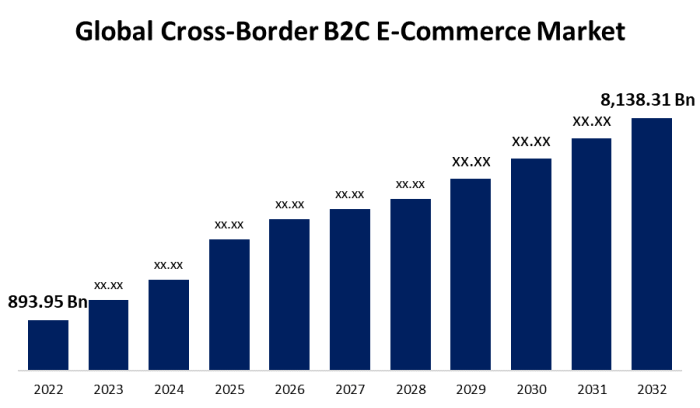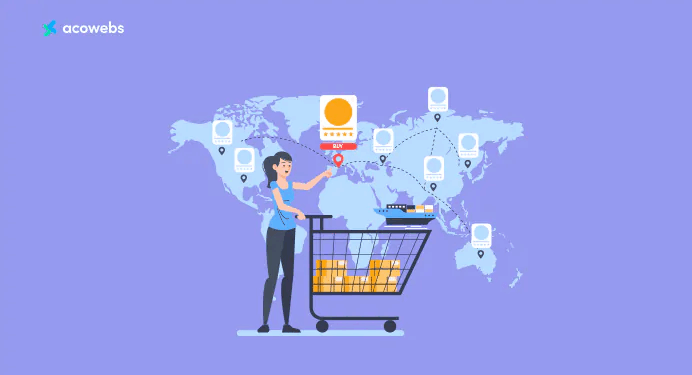
Delving into the realm of cross-border ecommerce market unveils a landscape filled with innovation, challenges, and endless opportunities for global trade expansion. As businesses navigate through diverse regulatory landscapes and technological advancements, the evolution of cross-border commerce continues to shape the future of international business transactions.
The following paragraphs will delve deeper into the key aspects of this dynamic market, shedding light on trends, challenges, technological advancements, and strategies that define the cross-border ecommerce ecosystem.
Introduction to Cross-Border Ecommerce Market
The cross-border ecommerce market refers to the buying and selling of goods and services online between businesses and consumers across different countries. This global marketplace allows businesses to reach a wider audience beyond their domestic borders, enabling them to explore new markets and increase their customer base.
Cross-border ecommerce plays a significant role in global trade by breaking down barriers that traditionally limited international business transactions. It promotes economic growth, fosters international relations, and creates opportunities for businesses to expand their reach on a global scale.
Examples of Successful Cross-Border Ecommerce Businesses
- Amazon: One of the largest ecommerce platforms in the world, Amazon operates in multiple countries and offers a wide range of products to customers globally.
- Alibaba: A leading Chinese ecommerce company, Alibaba facilitates cross-border trade between businesses and consumers worldwide through its various platforms.
- eBay: Known for its auction-style marketplace, eBay allows sellers to reach buyers from different countries, making it a popular choice for cross-border ecommerce transactions.
Market Trends and Growth Factors

In the rapidly evolving world of cross-border ecommerce, several key trends are shaping the market and driving its growth.
Key Trends in Cross-Border Ecommerce:
- The rise of mobile commerce: With the increasing use of smartphones and tablets, more consumers are opting to shop online through mobile devices, leading to a surge in cross-border ecommerce transactions.
- Expansion of global marketplaces: Ecommerce platforms like Amazon, Alibaba, and eBay are providing sellers with the opportunity to reach a global audience, facilitating cross-border trade.
- Enhanced logistics and fulfillment services: Improvements in logistics and fulfillment capabilities are reducing shipping times and costs, making cross-border ecommerce more efficient and accessible to consumers worldwide.
Factors Driving Cross-Border Ecommerce Growth:
- Increasing internet penetration: As more people gain access to the internet, the potential customer base for cross-border ecommerce expands, driving growth in the market.
- Advancements in technology: Innovations in payment processing, data security, and personalized shopping experiences are enhancing the cross-border ecommerce experience, attracting more consumers to shop internationally.
- Changing consumer preferences: The demand for unique products, better deals, and access to international brands is fueling the growth of cross-border ecommerce as consumers seek out new and diverse shopping options.
Comparison with Domestic Ecommerce Markets:
When comparing the growth rates of cross-border ecommerce with domestic ecommerce markets, it is evident that cross-border ecommerce is expanding at a faster pace. The global reach, increased product variety, and competitive pricing offered by cross-border platforms are attracting consumers looking for alternatives to their local marketplaces.
Challenges in Cross-Border Ecommerce
When operating in the cross-border ecommerce market, businesses face various challenges that can impact their success. These challenges range from regulatory issues to logistical complexities, requiring careful navigation to ensure smooth operations.
Regulatory Differences Impact
Navigating regulatory differences is a significant challenge for businesses engaged in cross-border ecommerce. Each country has its own set of regulations regarding taxes, customs duties, data protection, and consumer rights. Adhering to these regulations while conducting business across borders can be complex and time-consuming.
Failure to comply with regulations can result in fines, delays, or even legal consequences, making it crucial for businesses to stay informed and adapt their strategies accordingly.
Logistics and Supply Chain Management
Logistics and supply chain management pose another set of challenges in cross-border ecommerce. Coordinating the movement of goods across international borders involves dealing with multiple carriers, customs procedures, and varying delivery times. Ensuring timely delivery, tracking shipments, and managing returns can be particularly challenging in a cross-border context.
Additionally, factors such as language barriers, currency conversions, and different packaging requirements add to the complexities of logistics and supply chain management in cross-border ecommerce.
Payment Methods and Currency Considerations
![[Infographic] Cross-Border E-Commerce Market in Southeast Asia – Boxme ... [Infographic] Cross-Border E-Commerce Market in Southeast Asia – Boxme ...](https://ecommerce.zonajakarta.com/wp-content/uploads/2025/08/banner-infographic-2048x1077-1.jpg)
When it comes to cross-border ecommerce transactions, understanding payment methods and currency considerations is crucial for successful international sales.
Popular Payment Methods
- Credit cards: One of the most common payment methods used in cross-border transactions due to its convenience and widespread acceptance.
- PayPal: A popular choice for online payments, offering security and buyer protection.
- Bank transfers: Direct bank transfers are another option, although they may involve higher fees and longer processing times.
- Digital wallets: Services like Apple Pay or Google Pay are gaining popularity for their ease of use on mobile devices.
Currency Conversion and Exchange Rate Fluctuations
It's important to consider currency conversion rates and fluctuations when conducting cross-border ecommerce. Exchange rates can impact pricing, profit margins, and customer perception.
Fluctuations in exchange rates can lead to unexpected costs or losses for businesses selling internationally.
Strategies for Managing Currency Risks
- Hedging: Utilizing financial instruments to protect against adverse exchange rate movements.
- Pricing strategies: Adjusting prices to account for currency fluctuations and maintain profitability.
- Multi-currency accounts: Using accounts that allow you to hold and manage funds in different currencies to minimize conversion costs.
- Monitoring: Keeping a close eye on exchange rate trends and adjusting strategies accordingly.
Technology and Innovation in Cross-Border Ecommerce
Technology has played a crucial role in transforming cross-border ecommerce operations, making it more efficient and accessible to a global audience. The integration of advanced technologies such as AI, machine learning, and data analytics has revolutionized the way businesses approach cross-border sales, offering personalized experiences and optimizing overall performance.
Role of AI, Machine Learning, and Data Analytics
AI, machine learning, and data analytics are instrumental in enhancing cross-border ecommerce by providing valuable insights into consumer behavior, preferences, and trends. These technologies enable businesses to predict customer needs, tailor marketing strategies, and optimize product recommendations based on real-time data analysis.
By leveraging AI algorithms and machine learning models, companies can automate processes, improve decision-making, and enhance the overall shopping experience for customers.
- AI-powered chatbots and virtual assistants offer personalized assistance to customers, resolving queries and providing recommendations in real-time.
- Machine learning algorithms help in fraud detection, enhancing security measures to protect sensitive customer information during cross-border transactions.
- Data analytics tools analyze customer feedback and purchase history to identify trends, enabling businesses to tailor their product offerings and marketing strategies accordingly.
Innovative Technologies Enhancing Cross-Border Shopping Experiences
Innovative technologies continue to drive advancements in cross-border ecommerce, providing seamless and convenient shopping experiences for consumers worldwide. From virtual reality (VR) fitting rooms to augmented reality (AR) product visualization, these technologies bridge the gap between online and offline shopping, offering immersive and interactive experiences for customers.
- Blockchain technology ensures secure and transparent cross-border transactions, eliminating intermediaries and reducing transaction costs.
- Voice commerce and smart speaker integration enable customers to make purchases using voice commands, simplifying the shopping process and enhancing accessibility.
- Personalization engines use data-driven insights to deliver tailored product recommendations, promotions, and content to customers, enhancing engagement and driving conversions.
Market Entry Strategies for Cross-Border Ecommerce
![The Growth in cross-border Ecommerce [Infographic] | Smart Insights The Growth in cross-border Ecommerce [Infographic] | Smart Insights](https://ecommerce.zonajakarta.com/wp-content/uploads/2025/08/Global-Cross-border-Ecommerce-Statistics.png)
When it comes to venturing into cross-border ecommerce, businesses have several market entry strategies to consider. Each strategy comes with its own set of benefits and challenges, influencing the success of international expansion efforts. One common approach is utilizing online marketplaces to reach a global audience, while another key factor is the importance of localization and cultural adaptation for effective international ecommerce expansion.
Using Online Marketplaces for Cross-Border Sales
Online marketplaces such as Amazon, eBay, and Alibaba provide businesses with a ready platform to showcase and sell their products to a global customer base. The benefits of using online marketplaces for cross-border sales include access to a large pool of potential customers, built-in trust and credibility, and streamlined logistics and payment processes.
However, challenges such as increased competition, marketplace fees, and limited control over branding and customer data should also be taken into consideration.
Localization and Cultural Adaptation in International Ecommerce Expansion
In order to succeed in cross-border ecommerce, businesses must prioritize localization and cultural adaptation. This involves customizing websites, product descriptions, and marketing messages to resonate with the target audience in different countries. By understanding local preferences, language nuances, and cultural norms, businesses can build trust with international customers and enhance their overall shopping experience.
Neglecting localization can lead to misunderstandings, lack of trust, and ultimately, lower sales conversion rates in foreign markets.
End of Discussion
In conclusion, the cross-border ecommerce market presents a complex yet promising avenue for businesses seeking international growth. By adapting to evolving trends, overcoming regulatory hurdles, and leveraging innovative technologies, companies can unlock new possibilities in the global marketplace. As the landscape continues to evolve, staying informed and agile will be key to thriving in this dynamic sector.
FAQ Section
What are the common challenges faced by businesses in the cross-border ecommerce market?
Common challenges include navigating complex regulatory frameworks, managing logistics across borders, dealing with currency fluctuations, and addressing cultural differences in target markets.
How do currency conversion and exchange rate fluctuations impact cross-border ecommerce transactions?
Currency conversion and exchange rate fluctuations can affect pricing, profitability, and overall competitiveness of cross-border ecommerce businesses. It's essential to have strategies in place to mitigate these risks.
What role do AI, machine learning, and data analytics play in optimizing cross-border sales?
AI, machine learning, and data analytics help businesses analyze consumer behavior, personalize marketing strategies, streamline operations, and enhance customer experiences in cross-border ecommerce.











